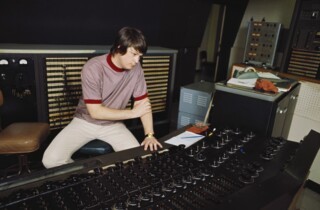I Can Hear Music
Chris Larkin
Junction 15 of the M25 may not be the first place that comes to mind when you think of escapism, but for me as a child in the late 1980s, joining the M4 was crossing a watershed. We visited my grandparents in Wales every summer, and not only did leaving the London Orbital mean we were properly on our way, it was also the point at which I was allowed to ask for music to be played. I always asked for The Best of the Beach Boys. (No one objected: my father had loved the Beach Boys since the 1960s, even before his older brother moved to the US.) Their songs weren’t just the soundtrack to a car journey to Wales, but a gateway to an America of the mind.
Brian Wilson, who died this week at the age of 82, was the creative centre of the Beach Boys. The early surf hits – ‘Surfin’ Safari’, ‘Fun, Fun, Fun’, ‘I Get Around’ – radiated brightness, but it was Wilson’s harmonic ambition that lifted the songs above simple chart fodder. He was listening to Gershwin and Bacharach, arranging intricate vocal lines in his head, layering falsetto over baritone in brushstrokes of sound. Those early tracks tapped into – and helped to propagate – a postwar Southern Californian mythology: beaches, high school proms, convertibles.
But Wilson wasn’t content with churning out catchy ballads of young love, car racing and surf culture. The 1963 single ‘Be True to Your School’ was all high school pep and cheerleaders, but the B-side was something else entirely. With ‘In My Room’, Wilson was starting to explore a new side of his songwriting; the harmonies are still there, but they recede into something more intimate and introspective. There’s a sense of unease and a desire for refuge from the loud, bright, unpredictable world outside. It pointed in a new direction, leading three years later to Pet Sounds.
Often cited as one of the greatest albums of all time, Pet Sounds is quite a strange record in many ways. It still has the recognisable themes of earlier albums – wistful love songs, coming of age fears and adolescent adventure – but the unerring optimism has disappeared. The love songs question themselves, coming of age is filled with unease and adolescence feels fraught. The arrangements are more experimental – stacked vocals, odd chord progressions, improvised instruments such as bells and cola bottles, sudden shifts in key, tempo and mood. It was a relative commercial failure, but hugely influential. And ‘Good Vibrations’, released a few months after Pet Sounds, may still be the best pop song ever made, a song so intricate and multi-faceted it’s almost impossible to keep up with it while listening.
But Pet Sounds also marked a turning point in Wilson’s mental state. He became ever more reclusive, taking more drugs and relying on various psychiatrists and hangers-on to remain stable. He performed on and off throughout the next few decades, but was never the same on a physical, mental or creative level. The early 2000s saw him well enough to complete and tour the ‘lost’ album Smile, but there was always a sense he was being carried by the new band he’d gathered around him. The harmonies were there, they sounded like the Beach Boys, but they never really felt like them.
As a child strapped in the back of a Volvo somewhere near Leigh Delamere services, I knew almost nothing of California. But Brian Wilson made me believe in it. The harmonies he created conjured visions of sun-bleached houses, longing glances, soft melancholy and endless summers.
